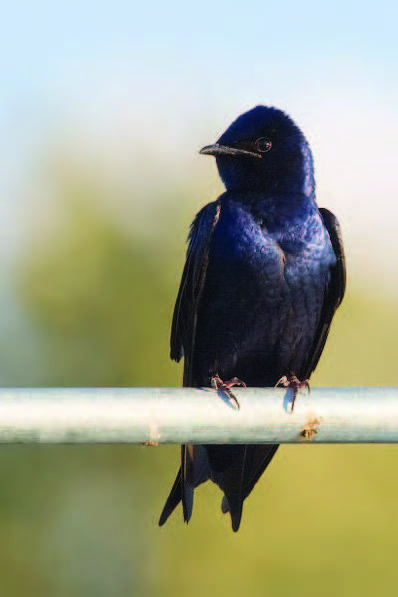
Purple Martins are actually a gorgeous dark blue-black. In our area they are usually heard chortling high over open fields or water, as they fly catching bugs. They are considered to be rare or uncommon breeders here because their population has declined drastically. This is thought to be due to their need for multiple cavities as they are colonial cavity nesters. They formerly nested in dead snags but, due to fire suppression and logging, dead standing trees are hard to come by. Also, the introduced European Starlings and House Sparrows out-compete the Purple Martin for those holes.
At eight inches the Purple Martin is the largest swallow. The male is glossy dark-blue all over. The female and juveniles are sooty-gray underneath. They have a slightly forked tail and broad, pointy wings. They feed mostly in flight, catching bugs such as flies, mosquitoes, butterflies and, one of their favorites, dragonflies. They also drink and bathe on the wing. Historically, Native Americans hung dry gourds and calabash for them to nest in. On the east coast they nest in huge birdhouses with some houses holding over two hundred pairs. Along our coast, they have adapted to nest in the drain holes under bridges (Caltrans cooperated with a local birderís request that the new drain holes be designed to accommodate the martins. Ed.). They have been found nesting under the bridges over Gualala, Greenwood Creek, Noyo and Juan Creek and even the newly constructed Ten Mile Bridge.
Purple Martins are occasionally polygamous with males having more than one mate. It is thought that males choose and defend a nesting hole and the females later choose the best site and the male goes along with it. They both construct the nest, using grass, feathers, plants and occasionally crayfish legs. Sometimes a mud rim is added to stop the eggs from rolling out. The female incubates four to five eggs for two weeks. The young fledge in about a month.
Before migration, Purple Martins collect in enormous roosts, sometimes numbering up to one hundred thousand, before leaving for places like Bolivia, Venezuela and Brazil for the winter.
Purple Martin adult male photo J. J. Cadiz
